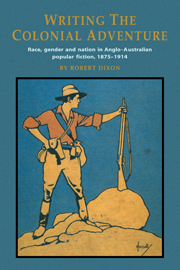 Writing the Colonial Adventure
Writing the Colonial Adventure Book contents
- Frontmatter
- Contents
- List of Illustrations
- Acknowledgements
- Introduction
- 1 The Romance of Property: Rolf Boldrewood and Walter Scott
- 2 Outlaws and Lawmakers: Boldrewood, Praed and the ethics of adventure
- 3 Israel in Egypt: The significance of Australian captivity narratives
- 4 Imperial Romance: King Solomon's Mines and Australian romance
- 5 The New Woman and the Coming Man: Gender and genre in the ‘lost-race’ romance
- 6 The Other World: Rosa Praed's occult fiction
- 7 The Boundaries of Civility: Australia, Asia and the Pacific
- 8 Imagined Invasions: The Lone Hand and narratives of Asiatic invasion
- 9 The Colonial City: Crime fiction and empire
- 10 Beyond Adventure: Louis Becke
- Conclusion
- Notes
- Select Bibliography
- Index
7 - The Boundaries of Civility: Australia, Asia and the Pacific
Published online by Cambridge University Press: 05 November 2011
- Frontmatter
- Contents
- List of Illustrations
- Acknowledgements
- Introduction
- 1 The Romance of Property: Rolf Boldrewood and Walter Scott
- 2 Outlaws and Lawmakers: Boldrewood, Praed and the ethics of adventure
- 3 Israel in Egypt: The significance of Australian captivity narratives
- 4 Imperial Romance: King Solomon's Mines and Australian romance
- 5 The New Woman and the Coming Man: Gender and genre in the ‘lost-race’ romance
- 6 The Other World: Rosa Praed's occult fiction
- 7 The Boundaries of Civility: Australia, Asia and the Pacific
- 8 Imagined Invasions: The Lone Hand and narratives of Asiatic invasion
- 9 The Colonial City: Crime fiction and empire
- 10 Beyond Adventure: Louis Becke
- Conclusion
- Notes
- Select Bibliography
- Index
Summary
In his book Culture and Truth: The Remaking of Social Analysis, the anthropologist Renato Rosaldo calls for a new ethnography of the borderlands between cultures. Under classic norms, he argues, ‘the borders between nations, classes, and cultures were endowed with a curious kind of hybrid invisibility’. Ethnographers now look ‘less for homogeneous communities than for the border zones within and between them’. These cultural border zones, Rosaldo argues, are always in motion.
In this chapter I use the thematics of travel and border zones to frame a reading of a group of adventure novels that construct discursive boundaries between Australia, Asia and the Pacific immediately before and after Federation. They are Alexander Macdonald's The Island Traders (1909), Ambrose Pratt's The Big Five (1911) and Louis Becke's The Pearl Divers of Roncador Reef (1908). These texts inhabit a number of border zones. They were written by travellers who often lived on the margins of respectability. Their characters are also on the move: on horseback, under sail, under steam, and even in the new motor cars and airships. They travel in the mythologised borderlands of the new Australian nation: in the Northern Territory, Far North Queensland, South-East Asia and Melanesia.
In developing notions of the frontier, adventure stories tend to follow classic norms, affirming what Peter Hulme has called ‘the boundaries of civility’: they make visible the maintenance of discursive boundaries concerned with race, nation and gender.
- Type
- Chapter
- Information
- Writing the Colonial AdventureRace, Gender and Nation in Anglo-Australian Popular Fiction, 1875–1914, pp. 118 - 134Publisher: Cambridge University PressPrint publication year: 1995


